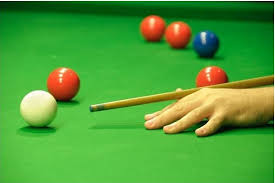Science > Physics > Force > Law of Conservation of Momentum
In this article, we shall study the law of conservation of momentum and its proof.
Statement:
When the resultant external force acting on a system is zero, the total linear momentum of the system is constant. OR When no external force acts on a system of bodies and there is collision among them then the total linear momentum before the collision equals to the total momentum after the collision.
Explanation :
Let us consider two bodies having masses m1 and m2 moving towards each other along the same straight line with velocities u1 and u2 respectively. Let v1 and v2 be their velocities after the collision.
By the law of conservation of momentum,The total momentum of the system before collision = The total momentum of the system after collision
m1u1+ m2u2 = m1v1+ m2v2.
This law is universal because It is not only true for the collision of astronomical bodies but also for collision of subatomic particles.
Proof:
Let us consider two bodies having masses m1 and m2 moving towards each other along the same straight line with velocities u1 and u2 respectively.

The total momentum of the system before collision = m1u1 – m2u2 …………….(1)
When two bodies collide body of mass m1 exerts pressure F on the body of mass m2. This is action. By Newton’s third law of motion body of mass m2 exerts force – F on the body of mass m1. This is a reaction. Thus resultant force acting on the system is zero.

Let the bodies of mass m1 and m2 move with velocities v1 and v2 respectively as shown in the diagram.

The total momentum of the system after collision = – m1v2 + m2v2 ……….. (2)

From equations (3) and (4) Thus, the total momentum of the system before collision = The total momentum of the system after the collision. Thus the law of conservation of momentum is proved.
Numerical Problems:
Example – 01:
A ball of mass 100 g moving at a speed of 12 m/s strikes another ball of mass 200 g at rest. After the collision both the balls stick to each other and move with a common velocity. Find the common velocity.
Given : mass of first ball = m1 = 100 g = 0.1 kg , initial velocity of first ball = u1= 12 m/s, mass of the second ball = m2 = 200 g = 0.2 kg , initial velocity of second ball = u2 = 0 m/s,
To Find: common velocity = v = ?
Solution:
Let v m/s be their common velocity after collision
Final velocitie v1 = v2 = v ms-1.
By Law of Conservation of momentum
m1u1+ m2u2 = m1v1+ m2v2
∴ (0.1)(12) + (0.2)(0) = (0.1)(v) + (0.2)(v)
∴ 1.2 + 0 = 0.3 v
∴ v = 1.2/0.3 = 4 m/s
Ans: Their common velocity is 4 m/s
Example – 02:
A gun fires a bullet of mass 50 g with a velocity of 30 m/s because of which the gun recoils with a velocity 1 m/s. Find the mass of the gun.
Given : mass of bullet = m1= 50 g = 0.050 kg , velocity of bullet = v1 = 30 m/s, recoil velocity of gun = v2 = 1 m/s.
To Find: mass of gun = m2 = ?
Solution:
By law of conservation of momentum
Mass of gun x Recoil velocity of gun = Mass of bullet x Velocity of bullet
m1v1 = m2v2
∴ 0.050 x 30 = m2 x 1
∴ m2 = 1.5 kg
Ans: The mass of the gun is 1.5 kg.
Example – 03:
A railway engine of mass 2 tons moving at a speed of 72 km/hr, collides with a wagon at rest. After the collision, both have a common velocity of 36 km/hr. Find the mass of the wagon.
Given : mass of engine = m1 = 2 T = 2000 kg, initial velocity of engine = v1 = 72 km/hr = 72 x 5/18 = 20 m/s, Mass of wagon = m2 = Mass of wgon
To Find: Mass of wagon = m2 = ?
Solution:
Let ‘v m/s be their common velocity after collision
v1 = v2 = v = 36 km/hr = 36 x 5/18 = 10 m/s
By Law of Conservation of momentum
m1u1+ m2u2 = m1v1+ m2v2
∴ (2000)(20) + (m2)(0) = (2000)(10) + (m2)(10)
∴ 40000 + 0 = 20000 + 10(m2)
∴ 40000 – 20000 = 10(m2)
∴ 20000 = 10(m2)
∴ m2 = 20000/10 = 2000 kg
Ans: The mass of the wagon 2000 kg.
Example – 04:
A bullet of mass 50 g is fired from a gun. If the bullet acquires a velocity of 100 m/s in 0.1secondsd. What is the recoil force on the gun?
Given : mass of bullet = m = 50 g = 0.05 kg, initial velocity of bullet = u = 0, final velocity of bullet = v = 100 m/s, time taken = t = o.1 s
To Find: recoil force = F = ?,
Solution:
a = (v – u)/t = (100 – 0)/0.1 = 100/0.1 = 1000 m/ s2
Force on bullet = m.a = 0.050 X 1000 = 50 N
By Newton’s third law of motion, the recoiling force on the gun is 50N.
Ans: Recoil force on the gun is 50 N
Previous Topic: Simple Numerical Problems on Force
Next Topic: Elastic and Inelastic Collision
